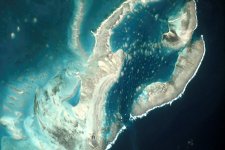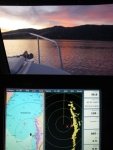Joe, you have raised a lot of good points. Electronics have made navigation safer but they can lead to complacency and less stringent "watch keeping". One thing I do in unfamiliar waters is cross check the depth on my depthmeter with the depth on the chartplotter where it says I am. They should match!
Rob, No one knows exactly what happened here. Yes the course should have been well outside (to the East--see the photo below) where the water is over 12,000 feet. Most of the area they are racing in is in the many thousands of feet--and way below what their depth finder would register. Since this part of the ocean is pretty much out of the main shipping lanes, it is not well charted, as to depth, and the landmasses/reefs may be not in an accurate position. There is no good forward scanning sonar, which would not slow the boat down. Who would watch the depth finder all of the time? Even an alarm may not be heard. There are 8 men (10 in the all woman crew) on the crew. There is also a non sailing reporter aboard each boat. This means 4 on a watch--they are on the boat weeks at a time, sleep is difficult--more like exhaustion rest…You are in a drum or kettle (it can be very noisy), it is hot, there may not be much ventilation etc. 4 is a minimum crew to just run the boat (since these are hand steered, not auto pilot like the single handed boats). We had 10 man crews on 45 to 55 foot boats, and that was a handful. Even there the navigator was also a helmsman, as well as having to work other positions, such as bowman.
The boats are capable of speeds of 30 knots--it is unclear how fast the boat was going when she hit the reef. I have read from 9 to 20 knots. One of the boats averaged over 20 knots in a 24 hour run!
Note the deep blue of a sudden drop off to the East of the reef.

In Canada's far north "old school" Eskimo's are often hired for patrol's. Apparently they can cover hundreds of miles with greater accuracy using the stars than others using GPS.
Although the Eskimos are most likely very good navigators, and skilled seaman, GPS has a accuracy of a few feet today. I can assure you that even the best celestial navigator, using the best of instruments is gong to have an error far greater than any off the shelf GPS today. I suspect the success of native navigators is their knowledge of the sea.
I read about a couple who live aboard a relatively small sailboat. They have no motor and use no electronic navigation equipment. They sail everywhere using the stars to navigate. They use a tallow filled lead line to check depth and bottom.
Most likely you are referring to Lyn and Larry Pardey and Tallisen. Tallisen is for sale currently. They did not have an engine in any of their boats, and do not use electronics, except a SSB receiver (time signals). We were at the launching of Tallisen in Long Beach. Lyn and Larry have chosen to voyage in conditions we might not choose, but what many sailors were forced to use for centuries.
Sad to see some skills disappearing that took man so long to learn and perfect.
I don't think that these skills are lost. They have been improved during my lifetime (I used celestial navigation for my first long voyages. Good time reception and manual calculations made it slow. In the 70's mini computers (Calculators with a navigation library) were developed to do the calculations, and very accurate electronic watches replaced a regulated chronometer and checking the time ticks on WWV/WWVH.) You can still buy sextants, nautical almanacs and tables. there are plenty of folks who still practice celestial navigation…Maybe more threatened is cursive writing! :smile
Not sure how much of the "news" one can believe at times, but there was a blurb tonight, that this boat was removed from the reef, and now they are looking at a fast repair to get back into the race.
Harvey, I have checked the various blogs, and I suspect that someone is misquoting. The boat is very badly damaged. Not only is the bottom and stern for the last 10 feet destroyed, but all wiring has been ripped out, the steering is gone. The canting keels, all electronics/electrical and many other parts of the boat are trashed.
Then there is the question of how to get the boat off the reef. Dragging it would destroy the rest of the hull. Trying to raise the boat up with air bags and or jacks, and build a sled under it to move it would just not be practical, because of the seas and tides. The boat is toward the deep water, but it is a lee shore (waves crashing on it) You cannot even get a crane barge near enough, if one of proper size happened to be available within a few thousand miles. Then there is the time factor in towing the boat to a place where the technology is available to rebuild the boat.
I don't believe that they even tried to salvage the rig--which alone is well many hundred thousand dollars. There is a huge chance of damaging the mast and rigging by trying to take it down where the boat is, and not worth the risk.
The boats are all identical, including everything on them. The cost is somewhere in the 6 million dollar range for each 65 footers, and the total expense of a team will be in the neighborhood of 20 million dollars, for the race--plus some other program costs.
Another question, is are there enough spares, and could a new hull be built in time for them to miss two legs and then continue in the race next year? That has been discussed.




